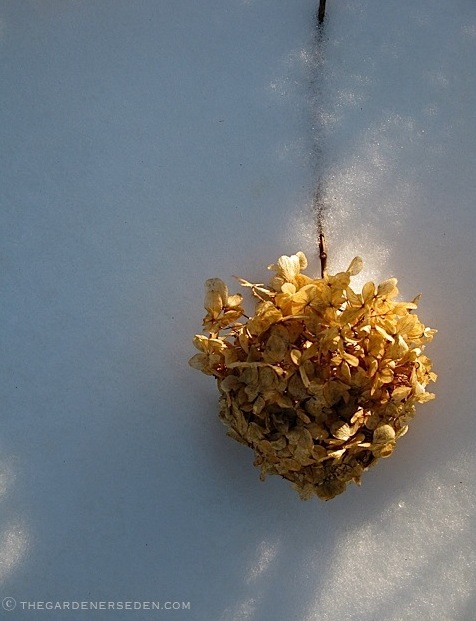Back in the Limelight Again …
 The Dew-Kissed Blossoms of Hydrangea paniculata ‘Limelight’ Sparkle in My Garden at Dawn
The Dew-Kissed Blossoms of Hydrangea paniculata ‘Limelight’ Sparkle in My Garden at Dawn
 A Lightly Fragrant, Fresh-Cut Beauty for the Late Summer Vase, Limelight Hydrangea Blossoms also Dry Beautifully  (Perfect for Autumn Arrangements & Winter Wreaths)
A Lightly Fragrant, Fresh-Cut Beauty for the Late Summer Vase, Limelight Hydrangea Blossoms also Dry Beautifully  (Perfect for Autumn Arrangements & Winter Wreaths)
 By October, Limelight has Morphed from Pale Pistachio to Strawberries and Crean and on to Honey-Drizzled Cherry Hues. Come Winter, the Blossoms Shift to Sugar-Coated Caramel. A Feast for the Eyes!
By October, Limelight has Morphed from Pale Pistachio to Strawberries and Crean and on to Honey-Drizzled Cherry Hues. Come Winter, the Blossoms Shift to Sugar-Coated Caramel. A Feast for the Eyes!
Some garden divas strut their stuff early in the season; stopping us in our tracks with outrageous June displays. Yes, the perfumed Peonies and romantic Roses make an unforgettable, early impression. But as every party-hopping bombshell knows, there’s a distinct advantage to the well-timed, late arrival. By mid-August, even the most star-studded garden parties can look a little tired. Somewhere in the middle of the dog days, all of the ephemeral, ingenues mysteriously disappear and the colorful garden conversations begin to fade. But wait —before you retrieve your party platter and bid the hostess adieu— out of nowhere, those gorgeous Hydrangeas slip through the back door to strike a pose. It may be late, but suddenly this Hydrangea paniculata has the stage all to herself, and she certainly knows how to sparkle in the Limelight…
 Limelight Blossoms Unfold Minty Vanilla to Pale Pistachio; Usually Beginning in Late July or Early August
Limelight Blossoms Unfold Minty Vanilla to Pale Pistachio; Usually Beginning in Late July or Early August
Hardy in USDA zones 3/4 – 8/9, H. paniculata ‘Limelight’ can reach a mature size of approximately 6-8′ tall and wide. Far more heat and drought tolerant than her cousins —particularly the thirsty H. macrophylla clan— this delightful shrub does best in full to partial sun and average garden soil. Because H. paniculata ‘Limelight’ blooms on new wood, I like to prune it back hard in early spring to keep the plant looking tidy and to encourage abundant, large flowers (I take down about 1/3 of the shrub, shaping as I go). In late July or early August —when so many plants wilt and fade in the humid air— newly emerging Limelight blossoms cool the garden with citrus-hued refreshment. Later on in the season —as temperatures drop and nightly frosts settle into the garden— Limelight responds to Jack’s kiss with a charming blush. Gorgeous! But the wonderful color transition doesn’t stop there either. As autumn waltzes toward winter, the over-sized blooms shift from honey-drizzled cherry to sugar-coated caramel; continuing straight through early snows until they take to the winter wind as rice-colored crisps!
 Last Year’s October Snow Caught the East Coast by Surprise. Damage was Extensive in New England, but the Hardy Hydrangea Blossoms in My Garden Took the Early Winter in Stride!
Last Year’s October Snow Caught the East Coast by Surprise. Damage was Extensive in New England, but the Hardy Hydrangea Blossoms in My Garden Took the Early Winter in Stride!
I’ve featured this favorite late-summer to late-autumn garden beauty here before. To read more about Limelight —a Proven Winners introduction— and some of her gorgeous garden companions, click back to my previous post here. Of course, my favorite part of growing hydrangea is cutting and sharing the blooms. Fresh or dried, Limelight Hydrangea blossoms are beautiful additions to flower arrangements.
 Hydrangeas are so Lovely, I Can Never Resist Cutting Bouquets to Share with Friends (Sprigs of Eucalyptus cinerea & Hydrangea paniculata ‘Limelight’ with Early Autumn Blush)
Hydrangeas are so Lovely, I Can Never Resist Cutting Bouquets to Share with Friends (Sprigs of Eucalyptus cinerea & Hydrangea paniculata ‘Limelight’ with Early Autumn Blush)
 Hydrangea paniculata ‘Limelight’ Blossoms in January Snow
Hydrangea paniculata ‘Limelight’ Blossoms in January Snow
Photographs and Text â“’ Michaela Medina/The Gardener’s Eden. All images, articles and content on this site (with noted exceptions), are the original, copyrighted property of The Gardener’s Eden and may not be reposted, reproduced or used in any way without prior written consent. Contact information is in the left side bar. Please do not take my photographs without asking first. Thank you!Â
Do you enjoy The Gardener’s Eden? You can help support this site by shopping through affiliate links. A small percentage of each sale will be paid to this site, helping to cover web hosting and maintenance costs. Thank you so much for your support!
